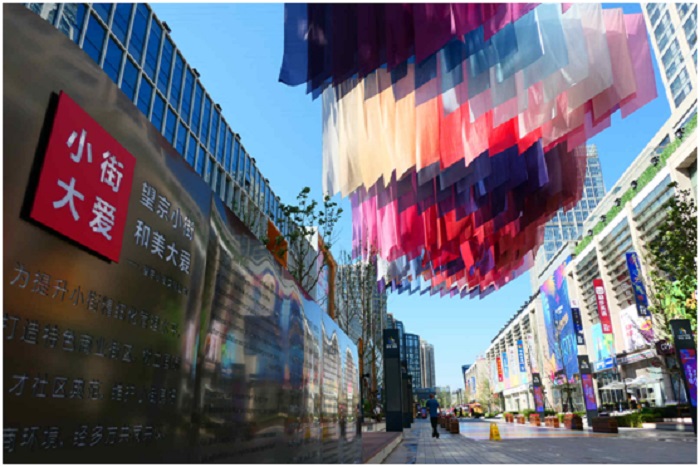



Wangjing Walk is a 380-meter-long pedestrian zone to the southeast side of Wangjing neighborhood, Chaoyang district of Beijing. It starts from Wangjing Street in the north and ends at Furong Street in the south.
In the past, the place was covered by rugged roads and bothered by domestic sewage, and over 100 motor vehicles and 400 shared bikes were “crawling” through it, leading to frequent fender benders.
Now it has been transformed into a beautiful pedestrian zone with well-designed booths and music fountain, and how did it happen?
“Why don’t we just turn it into a pedestrian zone since its traffic is so jammed?” Yang Xiaosheng, head of the Wangjing neighborhood office, introduced, adding that the transformation not only lifts the image of the place, but also makes it popular with the shops along it.
“We were also eager to see the changes,” said Liu Xiao, chief partner of Beijing Vanke, which runs a building that covers 55,000 square meters of offices and 20,000 square meters of commercial space to the east of the Wangjing Walk. Liu, who was also in charge of the upgrading project of the Wangjing Walk, told the People’s Daily that the environment of this place is a “signboard” of the commercial complexes on the two sides of it, and no enterprise was willing to headquarter in it no matter how magnificent the buildings were, because the “signboard” was ragged.
A final plan to renovate the place was formulated last October.
“It was not just a simple facelift, but a comprehensive environmental upgrading that suits the development demand of the area,” Yang introduced. According to him, Wangjing neighborhood is home to residents from over 60 countries, as well as 1,113 foreign-related enterprises, so the Wangjing Walk shall be a window for high-level opening-up.
At present, the wide pedestrian zone is paved by gravels, and a “rosy sky”designed by German artists hangs above it. Besides, fairs, exhibitions, and artistic corridors designed by students from the Central Academy of Fine Arts have been opened on the two sides of the pedestrian zone. Now, the zone satisfies both the consumption demands of its international residents, and the commercial needs of domestic and foreign enterprises.
Leading enterprises in the new media industry have been introduced to the office buildings in the Wangjing Walk, and the traditional mall there has been transformed into a modern complex that gathers catering, cinema, bars, and supermarkets.
To cope with the problem of insufficient parking space, Vanke introduced a smart parking system that integrates the parking resources in nearby residential complexes, malls and hotels through mobile payment, Internet of Things, artificial intelligence and big data. By doing so, the management of the parking space became much easier.
After renovation, Wangjing Walk started official operation on Aug. 8. “Our turnover exceeded 40,000 yuan ($5826) that day, and our business has also recovered by 80 to 90 percent so far, with a monthly turnover of around 800,000 yuan,” said an employee of a hot pot restaurant in the pedestrian zone.
Driving both consumption and investment and upgrading both consumption and industries, the renovation project is releasing huge energy.


The Executive and members of the.


The Acting Director, FCT Directorate of.


President Bola Ahmed Tinubu has been.



Barely a month after resignation of.


An Abuja based Legal Practitioner, Osuagwu.



Convener of Equitable Remedy, Mrs. Magaret.


Contractors handling the contract for city.


Nigerian government may have concluded plans.


The Diplomatic Correspondents Association of Nigeria.


A rights group, “Follow Me Talk.
Leave a Comment